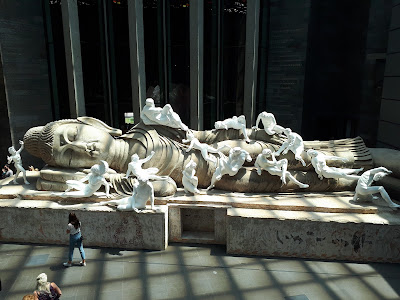It was all colour, shape and excitement at the National Gallery of Victoria’s Triennial exhibition which features the works of over 100 artists from 32 counties. The artworks explore international perspectives through art, design, technology and architecture.
One of the first Triennial pieces is encountered in the
entrance hall and summarises some of the most interesting ideas in art at the
moment. Xu Zhen’s monumental sculpture, Eternity-Buddha,
replicates the reclining Buddha from the High Tang Dynasty.
Covering the
colossal body are replicas of some of the most iconic sculptures from the
Western canon, including the Farnese Hercules, Milo of Croton and Crouching
Aphrodite. It is a hugely powerful piece, not only in its extreme scale, but in
its wider commentary on heritage, culture and the arts. Zhen has merged such
disparate imagery to create something remarkable, showing Western and Eastern
arts should compliment one another. Yet, Zhen has also made the Eastern figure
far larger than the Western ones, perhaps questioning whether there is an
imbalance in the Euro-centric art market that needs to be addressed. This
beautiful, thought-provoking and international artwork represents many of the
themes explored by the Triennial.
 |
| Xu Zhen, Eternity- Buddha in Nirvana, 2016-17 |
The artworks are spread throughout the gallery’s permanent
collection, as well as in separate exhibition spaces. It is an all-encompassing
display that encourages visitors to take part in the gallery experience. This
is not an exhibition that allows for passive wandering through turgid white
rooms. As viewers we must look, what
is part of the NGV’s permanent collection? What is new here? What is
interactive and what can’t be touched?
Ron Mueck’s large scale sculptures of skulls are positioned
in the NGV’s international galleries, amongst paintings by Canaletto and
Rembrandt. Particularly with regards to Dutch still life symbolising death and
mortality, these skulls seem to have rolled straight out of a 17th
century painting. In this way, they encourage fresh understanding of older
paintings we may feel we already know. Mueck’s artworks are startling, morbid, and
yet strangely intriguing and beautiful. They allow for interaction, encouraging
visitors to walk through the maze of skulls.
Pae White’s graphic installation uses acrylic yarn to warp
our viewing of the world around us, infusing our space with colours and shapes.
It blurs the line between art, craft, technology and architecture. Visitors in
this room seemed unsure where the artwork started and finished. It was
fascinating to see the NGV security guards tirelessly trying to protect the
piece ‘Don’t stand on the string!’ ‘Don’t touch the string!’ It became part of
the art itself. At what point does the art become part of our own environment
and cease to be art at all?
 |
| Lying on Alexandra Kehayoglou's hand tufted rug, Santa-Cruz River, was incredibly relaxing and almost hypnotically calm |
 |
| Jonathan Owen's Untitled (2016) was displayed alongside sculptures by Rodin, and provided additional insights into changing views of the human body in art |
It would be impossible to give justice to the entire
exhibition in its enormity by writing about each piece in turn. It is simply
too large and also too interactive and personal. Each visitor will see
something different, experience something more. It is successful, not only in
its selection and content, but in its display. By viewing contemporary pieces
alongside older, more traditional art forms, we are able to better appreciate
art in its power, and its transcendence over time. As something that has been
recommended by every Melbournian I’ve encountered during my first week here, it
is definitely worth visiting.







No comments:
Post a Comment